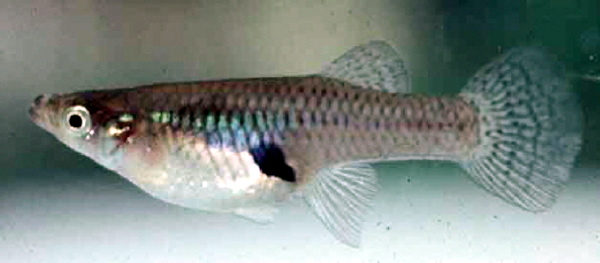
The amazing counting mosquitofish. Image courtesy Wikipedia
Eight years ago I published a book about a fight over how to count fish. Now it turns out that fish themselves can count. The account below comes from the BBC's natural history site, loveearth.com -- which is a well worth visiting anyway, full of visual and scientific wonders. The original paper is in Animal Cognition -- unfortunately, behind the usual absurdly expensive firewall ($32 for this article). Luckily there are science writers at the BBC to write this up:
Researchers find fish that can count up to four
Fish can count. We know that fish are able to tell big shoals from small ones, but now researchers have discovered that fish can actually count how many other fish are nearby.
'We have provided the first evidence that fish exhibit rudimentary mathematical abilities,' says experimental psychologist Christian Agrillo of the University of Padova in Italy, who made the discovery while studying a group mosquitofish (Gambusia holbrooki).
.... [The reseachers found that] the fish ... have a rudimentary ability to count, and that they appear to do so using similar cognitive mechanisms as other, higher vertebrates. 'They show a performance very similar to what is observed in apes, monkeys and dolphins,' Agrillo says.
The article then goes on to describe the clever experiments used to ferret out the counting ability:
[The research] team first conducted a series of experiments to see whether a lone mosquitofish would prefer to join a shoal of between two and four others. Females preferred to join shoals that were larger by just one fish significantly more often; consistently preferring shoals of four fish rather than three fish, and consistently preferring shoals of three fish over those containing just two. This means the fish were clearly able to count up to four and demonstrates that fish have a rudimentary mathematical ability to visually count how many items are present if the number is small.
A second series of experiments revealed the fish’s ability to process larger numbers. The fish were not able to directly count over four, but they were able to distinguish between larger numbers if they differed by a ratio of 2:1. For example, the fish could distinguish between a shoal of 16, compared to a shoal of eight others. But they could not tell the difference between a shoal of 12 compared to a shoal of eight, a ratio of 3:2. This demonstrates that fish are able to visually estimate larger numbers - but not very accurately.
I am fascinated to read of this testing for 2:1 ratios, for it is very similar to experiments that Harvard cognitive psychologist Liz Spelke and others have used to explore the numerical awareness, or "numerosity," as Spelke calls it, of human infants. I described Spelke's work in a profile for Scientific American Mind a while back. I'd love to know if the fish researchers took this method from Spelke and similar work.

From the 2nd hand descriptions (here & elsewhere), it seems like a poorly designed experiment, since none indicates that Christian Agrillo or his associates examined the 2 dimensional retinal image qualities of the chosen school. School density, individual size, vitality, proximity, etc. That is just bad science made shiny to attract the fish-eye lens of the media. My best guess at the quality of the research is that the best fish guess at the size of the school has a disk size discrimination limit of around 20%, rather than any ability to count. Sigh ; so much for copying my answer from a fishy schoolmate.